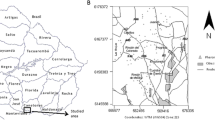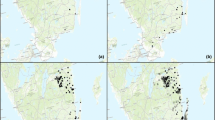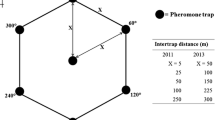Abstract
Red palm weevil Rhynchophorus ferrugineus Olivier is a key pest of date palm in the Kingdom of Saudi Arabia. Since 1994, the Ministry of Agriculture has implemented a pheromone-based integrated pest management (IPM) strategy to control R. ferrugineus in the Kingdom. Geographic information system (GIS) technology can serve as a valuable tool to assess insect activity and in addition the impact of the control strategy. We used GIS-based techniques to ascertain the spatial and temporal spread of R. ferrugineus in 234 ha of date plantation in Al-Sohemia-1 in the Al-Ahsa region of Saudi Arabia. One hundred and fifty six pheromone (Ferrolure™) traps in Al-Sohemia-1 were logged using the Trimble global positioning system to determine the east longitude and north latitude of each pheromone trap and transformed to the GIS as a shape file. The spatial and temporal variations for R. ferrugineus activity based on captures in pheromone traps were studied for each of the four seasons of the year and also year-wise during 2009 and 2010. Results revealed that during both 2009 and 2010, maximum weevil activity was recorded during late spring and early summer, with captures declining during autumn and winter. Spatial variations in the activity of R. ferrugineus indicated that in general 2009 registered lower weevil activity compared with 2010. Furthermore, most of the area exhibited medium to very high weevil activity in spring and summer during both 2009 and 2010, while most of the area recorded very low to low weevil activity during the autumn and winter seasons of both the years. The ongoing R. ferrugineus-IPM programme in Al-Ahsa needs to be strengthened in areas showing high to very high weevil activity.
Similar content being viewed by others
References
Abraham, V. A., Mahmood Al Shuaibi, Faleiro, J. R., Abozuhairah, R. A. and Vidyasagar, P. S. P. V. (1998) An integrated approach for the management of red palm weevil Rhynchophorus ferrugineus Oliv. — a key pest of date palm in the Middle East. Sultan Qaboos University Journal for Scientific Research (Agricultural Science) 3, 77–83.
Anonymous (1998) Final report of the Indian Technical Team (Part A) — Red Palm Weevil Control Project, Ministry of Agriculture and Water, Kingdom of Saudi Arabia, pp. 1–65.
Arctur, D. and Zeiler, M. (2004) Designing Geodatabases. Case Studies in GIS Data Modeling. ESRI Press, Redlands, CA, USA. 393 pp.
Barranco, P., Lorente-Moreno, F., Alcazar-Alba, M. D. and Pena-Mendez, Y. J. (2006) Control of Rhynchophorus ferrugineus in Spain: field tests and treatments. Proceedings, 1st International Workshop on Red Palm Weevil (IVIA), Valencia, Spain, 28–29 November 2005, 180 pp. Fundación Agroalimed. Jornada Internacional sobre el Picudo Rojo de las Palmeras. ISBN: 84-690-1742-X.
Brun, L. (2006) The date palm in Egypt: a traditional cash crop threatened by the red palm weevil. Proceedings, 1st International Workshop on Red Palm Weevil. (IVIA), Valencia, Spain, 28–29 November 2005, 180 pp. Fundación Agroalimed. Jornada Internacional sobre el Picudo Rojo de las Palmeras. ISBN: 84-690-1742-X.
Dembilio, Ó., Tapia, G. V., Tellez, M. M. and Jacas, J. A. (2012) Lower temperature thresholds for oviposition and egg hatching of the red palm weevil, Rhynchophorus ferrugineus (Coleoptera: Curculionidae), in a Mediterranean climate. Bulletin of Entomological Research 102, 97–102.
El-Garhy, M. E. (1996) Field evaluation of the aggregation pheromone of the red palm weevil, Rhynchophorus ferrugineus in Egypt. Brighton Crop Protection Conference: Pest and Diseases 3, 1059–1064.
El-Sabea, A. M. R., Faleiro, J. R. and Abo El Saad, M. M. (2009) The threat of red palm weevil Rhynchophorus ferrugineus to date plantations of the Gulf region of the Middle East: an economic perspective. Outlook on Pest Management 20, 131–134.
ESRI (2006) Using Arc GIS Desktop. Environmental System Research Institute, Redlands, CA. 442 pp.
Faleiro, J. R. (2006) A review of the issues and management of red palm weevil Rhyncophorus ferrugineus (Coleoptera: Rhynchophoridae) in coconut and date palm during the last one hundred years. International Journal of Tropical Insect Science 26, 135–154.
Faleiro, J. R., Ben Abdallah Abdallah, Ashok Kumar, J., Shagagh, A. and Al Abdan, S. (2010) Sequential sampling plan for area-wide management of Rhynchophorus ferrugineus (Olivier) in date palm plantations of Saudi Arabia. International Journal of Tropical Insect Science 30, 145–153.
Faleiro, J. R., El-Saad, M. A. and Abdul Hadi, A. H. (2011) Pheromone trap density to mass trap Rhynchophorus ferrugineus (Coleoptera: Curculionidae/Rhynchophoridae/Dryophthotidae) in date plantations of Saudi Arabia. International Journal of Tropical Insect Science 31, 75–77.
Malumphy, C. and Moran, H. (2009) Red palm weevil, Rhynchophorus ferrugineus. Plant pest fact sheet. Available online at https://doi.org/www.fera.defra.gov.uk (accessed 12 January 2012).
Martin, M. M. and Cabello, T. (2005) Biología y ecología del curculiónido rojo de la palmera Rhynchophorus ferrugineus (Olivier, 1790) (Coleoptera: Dryophthoridae) Departmento de Biología Aplicada. Universidad de Almería, Almería. 202 pp.
Massoud, A. M. (2008) Consultancy Report, submitted to the FAO of the United Nations on Completion of a 60 day GIS Mission (UTFN/SAU/012/SAU) on the Establishment of the GIS Unit at Hassa Irrigation and Drainage Authority (HIDA), Al-Hassa, Saudi Arabia. 35 pp.
Massoud, A. M., Faleiro, J. R., El-Saad, M. A. and Sultan, E. (2011) Geographic information system used for assessing the red palm weevil Rhynchophorus ferrugineus (Olivier) in date palm oasis of Al-Hassa, Saudi Arabia. Journal of Plant Protection Research 51, 234–239.
Oehlschlager, A. C. (2005) Current status of trapping palm weevils and beetles. The Planter 81, 123–143 (reproduced from Proceedings, Date Palm Regional Workshop on Ecosystem-Based IPM for Date Palm in the Gulf Countries. 28–30 March 2004, Al-Ain, UAE).
Schlyter, F., Zhang, Q.-H., Liu, G.-T. and Ji, L.-Z. (2003) A successful case of pheromone mass trapping of the bark beetle Ips duplicatus in a forest island, analyzed by 20-year time-series data. Integrated Pest Management Review 6, 185–196.
Soroker, V., Blumberg, D., Haberman, A., Hamburger-Rishad, M., Reneh, S., Talebaev, S., Anshelevich, L. and Harari, A. R. (2005) Current status of red palm weevil infestation in date palm plantations in Israel. Phytoparasitica 33, 97–106.
Author information
Authors and Affiliations
Corresponding author
Rights and permissions
About this article
Cite this article
Massoud, M.A., Sallam, A.A., Faleiro, J.R. et al. Geographic information system-based study to ascertain the spatial and temporal spread of red palm weevil Rhynchophorus ferrugineus (Coleoptera: Curculionidae) in date plantations. Int J Trop Insect Sci 32, 108–115 (2012). https://doi.org/10.1017/S174275841200015X
Accepted:
Published:
Issue Date:
DOI: https://doi.org/10.1017/S174275841200015X




